Articles Menu

Dec. 20, 2022
The number of fossil fuel-burning cars in Canada — and the climate pollution pouring out their collective tailpipes — keeps surging upwards, unchecked by climate targets, pollution policies or all-electric alternatives. Our burgeoning horde of internal combustion engines is locking in hundreds of millions of tonnes of climate pollution — and locking out Canadian climate progress. But, as we'll see below, not all nations have lost control of their vehicle emissions.
Here's a chart showing the latest Canadian vehicle registration numbers from Statistics Canada.
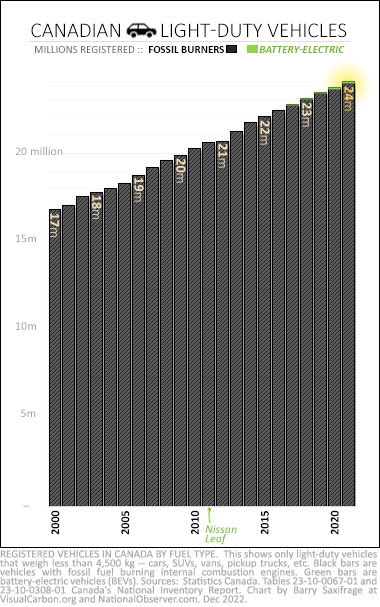
The height of each bar on the chart indicates the number of light-duty vehicles (cars, SUVs, vans and pickup trucks) registered each year in Canada.
The black bars are vehicles that burn gasoline and diesel. Their numbers have marched upwards like clockwork — from 17 million two decades ago to more than 24 million last year. It's a startlingly and relentless rise that's adding another million fossil burners to our roads every three years.
The zero-emission alternatives to fossil fuel burners are battery electric vehicles (BEVs). Their numbers are shown on the chart by the green bars on top. Yeah, not many. They're barely visible at this scale.
Back in 2011, the first mid-market BEV went on sale in Canada. It was the Nissan Leaf. In the decade since, nearly every major car company has rolled out their own BEVs. As the chart shows clearly, however, very few have been sold here.
Unsurprisingly, adding many more fossil fuel-burning cars to Canadian roads has led to lots more climate pollution pouring out of all those tailpipes.
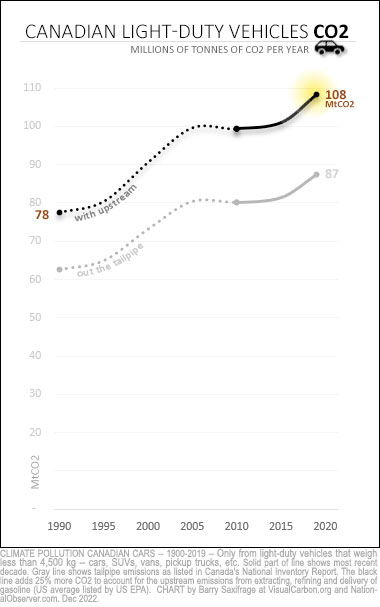 My next chart shows the resulting emissions surge from Canada's light-duty vehicles since 1990.
My next chart shows the resulting emissions surge from Canada's light-duty vehicles since 1990.
The lower grey line shows tailpipe emissions. That's the CO2 emitted by burning gasoline and diesel in the vehicles. These emissions have increased by 25 million tonnes of CO2 (MtCO2) per year since 1990.
The upper black line includes the "upstream" emissions from producing all that gasoline. This more complete climate impact accounting hit a record high of 108 MtCO2 in 2019. For scale, there are 170 countries whose total emissions are lower than that.
To avoid a truly dystopian climate future, we need to "bend our emissions curve" downward all the way to zero — and quickly. But as the chart above shows, we're accelerating in the wrong direction.
Canada's wrong way on tailpipe emissions reminds me of a driver who refuses to ask for directions no matter how off-track they get.
Canada's gasoline #emissions are surging out of control. @bsaxifrage writes for @NatObserver #GHG #CO2 #carbon #cdnpoli - Twitter
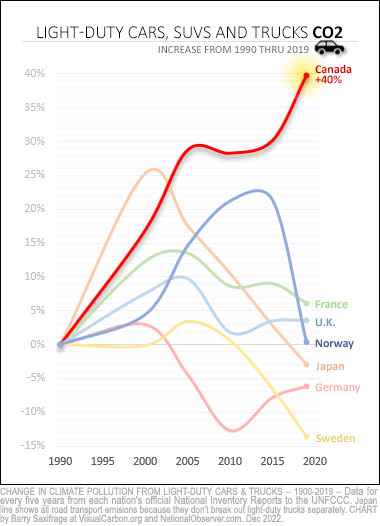
It turns out not all nations have lost control of their vehicle emissions. My next chart shows several examples. If Canadians want to turn our emissions around, we could follow one of the routes they've taken.
For example, Norway's light-duty vehicle emissions rose quickly for many years. But over the last decade, they've found a way to drive their tailpipe emissions sharply downward. They are now back to 1990 levels and falling fast. Their secret? A broad suite of vehicle taxes and policies based on the "polluter pays" principle. Canada could adopt these.
Our Commonwealth peers in the United Kingdom took a different path. They started acting earlier to rein in car emissions. They avoided a big upwards spike and managed to wrestle their tailpipe emissions back to 1990 levels more than a decade ago. Canada could adopt the key policies that have worked for the British.
France and Sweden both have new vehicle taxes based on the bonus-malus system. This is similar to what Norway does. It increases purchase taxes for high-emitting vehicles and reduces them for low- and zero-emitting vehicles. Canada could bring in a bonus-malus system as well.
The bottom line is that we know what policies have worked to bend the curve downward on vehicle emissions. Two of the most effective ones have been high taxes on burning gasoline and high taxes on purchases of new gas guzzlers. Without either one in Canada, we just don't have any brakes on our runaway vehicle emissions.
(Note: For an extended discussion on vehicle emissions policies in other nations, see the endnotes.)
The primary climate task facing societies is often summarized as: "electrify everything". When it comes to transportation, that means all light-duty cars and trucks on the road will need to be battery electric vehicles.
My next chart lets you see how far behind Canada is on this critical climate transition. The height of each bar on this chart indicates the percentage of new light-duty vehicle sales this year that have been BEVs.
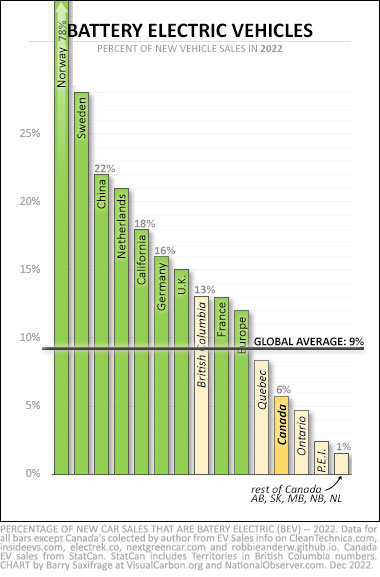
Canada is the deep yellow bar on the right. Only six per cent of new light-duty vehicles sold in 2022 were zero-emission BEVs.
That's well below the global average of nine per cent.
Most Canadian provinces are in even worse shape. They are shown by the light yellow bars.
Only British Columbians are doing better than the global average. Ontarians are limping along at half the global average. And all but four provinces are stuck in that last tiny bar on the right. They're lying flat with just one per cent of their new vehicle sales this year being zero-emission BEVs. One climate step forward … 99 fossil fuel steps backwards.
The green bars on the chart show how far ahead many other nations are. For example, the Europeans, overall, are choosing all-electric cars instead of new fossil fuel-burners twice as often as Canadians, the Chinese and Swedes four times more often, and the Norwegians 10 times more often.
For a compelling example of just how effective strong climate policy can be, let's compare what the Norwegians have been doing to what's happening in Alberta. Norway and Alberta have a lot in common. Both are high-income, oil-producing, cold northern regions. But when it comes to how much climate pollution they are locking in with their new car purchases, they're extreme opposites.
Norway's strong climate policies have incentivized Norwegians to choose a BEV nearly 80 per cent of the time. Alberta's relatively weak climate policies have incentivized Albertans to choose a BEV just one per cent of the time.
My next chart illustrates the huge difference this makes in vehicle emissions.
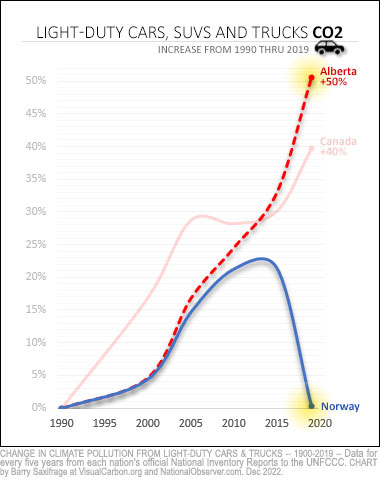
Alberta's tailpipe emissions are rocketing upwards even faster than Canada's. Not only are they heading in the wrong direction, but because they have been buying new fossil burners almost exclusively, they've locked in many years more of high emissions.
Norway's tailpipe emissions initially followed a startlingly similar upward path as Alberta's. But a decade of strong climate policies — charging high pollution fees when buying new fossil fuel-burners, combined with a range of benefits for zero-emission BEVs — has bent their emissions curve sharply downward.
Because new cars last so long, it requires strong policies like Norway's to be in place for many years to build up a cleaner vehicle fleet. And the critical target of those strong policies needs to be new vehicle sales. That's when years of climate pollution get locked in.
Norway did just that and is now reaping the benefits. There's no secret about the policies they used to incentivize buying zero-emissions electric vehicles instead of fossil fuel-burners. These policies are well-known and well-documented. If you want to read more about them, see the endnotes.
The takeaway message here is that good policies can turn rapidly soaring emissions into rapidly falling emissions.
A common complaint I hear about BEVs is that many made by legacy automakers can be hard to buy in Canada.
Many models aren't offered here at all, and many others have long and vague wait lists that can stretch for years. In addition, when legacy automakers do offer a BEV in Canada, they often sell their most expensive trims only. The more affordable base trims aren't made available to Canadians.
Why?
Legacy automakers aren't charities. They try to maximize their profits within the rules that governments set for them. And Canada's relatively weak vehicle emissions policies make it more profitable to sell gas-guzzlers here than BEVs. Here are two policy examples.
Fewer incentives to sell BEVs in Canada
Legacy automakers make more money selling their BEVs in other nations that have stricter vehicle emissions standards backed up with high fees if automakers don't meet them. This policy creates a financial incentive for legacy automakers to sell their BEVs there because each one sold reduces their emissions penalty.
More incentives to sell gas-guzzlers in Canada
Legacy automakers need to sell huge numbers of fossil fuel-burners somewhere. For example, 99 per cent of the cars made and sold by companies like Toyota, Honda and Subaru burn fossil fuels. Even at Volkswagen (the only legacy automaker with a BEV model in the global top 20) 94 per cent of the cars it made and sold this year were fossil burners.
And, critically, the most profitable models for legacy automakers are their biggest gas-guzzling SUVs and pickups. They need to prioritize sales of these wherever they can in order to maximize company profits.
And Canada is one of the best places remaining in the world where they can sell lots of these hyper-profitable, hyper-emitting vehicles. That's because we have such relatively weak vehicle emissions policies.
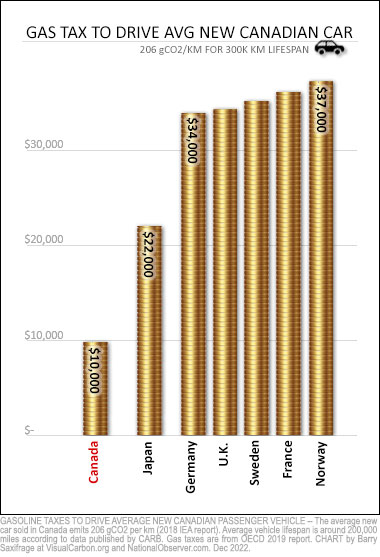
Let's look at the example of the average new car sold in Canada.
It turns out that Canadians buy the world's most climate-polluting new passenger vehicles. Our average new car emits 50 per cent more climate pollution per kilometre than the average new car in Europe.
One key policy that encourages Canadians to buy such hyper-emitting cars is our extremely low gasoline taxes. My chart shows how much higher the gasoline taxes are to drive the average Canadian car in other nations.
As you can see, it costs an extra $20,000 or more to drive such a climate-polluting vehicle in Europe. So, naturally, fewer Europeans buy big gas-guzzlers.
On top of that, many European nations add high taxes onto the purchase of new gas-guzzlers. These sales taxes increase in step with a new car's emissions per kilometre. In Norway, for example, their emissions-weighted sales tax can nearly double the price of a big new gas-guzzler.
These two policies — high gasoline taxes and high emissions-weighted vehicle taxes — can add tens of thousands of dollars to the cost of buying and driving a gas-guzzler. The European nations with these policies have incentivized legacy automakers to prioritize BEVs over gas-guzzlers there. And that, in turn, has been bending their vehicle emissions curve downward.
And vice versa. Nations like Canada with extremely low gasoline taxes and without steep emissions-weighted vehicle taxes are incentivizing legacy automakers to do the opposite. It's not a mystery when companies prioritize sales of their highest-margin products (gas-guzzlers) over their low-margin products (BEVs).
If Canadians want more BEVs from legacy automakers and falling vehicle emissions, then we can adopt the policies that have made this happen elsewhere.
------------------------
Endnotes
Norwegian policies and results
Norway has a dozen different taxes, subsidies and regulations that target vehicle emissions (click here).
The most important policy, by far, has been how they calculate the purchase tax on new cars. Here's how Norway's Electric Vehicle Association describes it:
"The purchase tax for all new cars is calculated by a combination of weight, CO2 and NOx emissions. The progressive tax system makes most EV models cheaper to buy compared to a similar petrol model… This is the main reason why the Norwegian EV market is so successful compared to any other country… This is obtained with the polluter pays principle in the car tax system. High taxes for high-emission cars and lower taxes for low- and zero-emission cars. Introducing taxes on polluting cars can partly finance incentives for zero-emission cars without any loss in revenues."
In addition, Norway's gasoline tax is nearly four times higher than what Canadians pay. It is equal to around $600 per tonne of CO2 emitted.
Nearly 20 per cent of all cars on Norway's roads are now BEVs. In Canada, less than one per cent are.
Robbie Andrew of the CICERO Center for International Climate Research maintains an excellent source for information, charts and data on Norway's electric vehicle transition.
British policies and results
An early example of British climate policy was the Fuel Duty Escalator enacted by the Conservative government of John Major back in 1993. Yeah, 30 years ago.
Its stated goal was to reduce the nation's climate pollution: “The largest contribution to the growth in United Kingdom carbon dioxide emissions in the coming years is expected to come from the transport sector … (this escalator will) provide a strong incentive for motorists to buy more fuel-efficient vehicles.”
That policy doubled British gasoline taxes during the 1990s. Today their gasoline taxes are more than triple Canada's — the equivalent of $560 per tonne of CO2 emitted.
Because they charge more to climate-pollute with their cars, the British buy much cleaner cars than Canadians. That's helped keep British tailpipe emissions from soaring out of control like Canada's have.
Other examples of early British policies are the London Congestion Charge Zone started in 2003 and the London Low Emissions Zone started in 2008. These levy fees on high-emitting vehicles and/or exempt low-emitting vehicles.
And 2008 was also the year the British introduced their sweeping carbon budget law. This requires the government to set legally binding five-year carbon budgets that must decline steadily to reach net zero by 2050. These carbon budgets must include all emissions in every year. And the government is required to enact policies needed to meet these budgets many years in advance to give citizens and businesses time to adjust. This law has forced the government to keep the nation's vehicle emissions in check in order to meet their carbon budgets. Which they have done.
As you may have noticed, tailpipe emissions from British cars have stopped declining in recent years. They're stalled out at just above their 1990 levels. They need to reduce them to meet their shrinking carbon budgets, so one policy being considered is the bonus-malus vehicle tax system used very successfully in many other European nations like Sweden and France. It is similar in concept to Norway's purchase tax discussed above. It increases vehicle taxes for high-emitting vehicles and lowers them for the low- and zero-emission vehicles.
Related articles
Interested in even more info on Canadian vehicle emissions? Here are a few more of my articles on this topic: